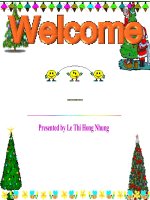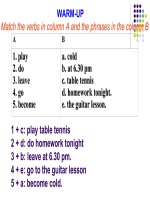Unit 1 language focus hoan chinh
Bạn đang xem bản rút gọn của tài liệu. Xem và tải ngay bản đầy đủ của tài liệu tại đây (3.96 MB, 40 trang )
Game show
“Follow pictures to catch
words”
JEANS
KEY
0124356789
0124356789
BRIDGE
KEY
PASSENGER
0124356789
KEY
CHILDREN
0124356789
KEY
CHURCH
0124356789
KEY
PICTURE
0124356789
KEY
jeans
bridge
passenger
=> / dʒ /
children
church
picture
=> / tʃ /
Listen and repeat.
/dʒ/ /tʃ/
jam ’dangerous
joke ’passenger
’January ’village
’children ’mutual
’changeable church
cheese which
Practise reading aloud these sentences.
1. Just outside the village, there’s a bridge.
2. Jane always enjoys George’s jokes.
3. Two jeeps went over the edge of the bridge.
4. Which picture do you think the child wants to change?
5. Mix the mushrooms, chilli and cheese.
6. Do you like French salad and fish and chips?
I. PRONUNCIATION
English
She learns English to go to the USA
S V O to _ inf
The dog makes the child cry
S V O V _bare ìnf
II. GRAMMAR :
1. Infinitive with to (to inf.)
ex: She learns English to go to the USA
ex ; To know how to swim is necessary
+ We can use to_inf :
_ We use to_inf to indicate the purpose of or intention
of the action
a. as subject of a sentence
b. as an object of a verb
ex ; She decided to stay at home
Notes : when we use to_inf as an subject , it is
more usual to begin the sentence with “It”
too+ adj (for someone) + to_inf
d. We use to_inf in idiomatic expressions :
ex : The tea is too hot for me to drink
adj + enough + to_inf
ex : Tom is old enough to understand the problem
e. We use to _ inf as an adverb to modify an adjective
ex : I am sorry to hear the news
ex : I have a lot of work to do ( which I have to do )
c. We sue to_inf after nouns or pronouns as a modifier
to replace a relative clause
Exercise 1: Put the words in the correct order to make
sentences, writing the main V in the present simple
and making the other an infinitive with to.
ex: train catch she a have -> She has a train to catch.
- lot of a housework there be do ->There is a lot of housework to do.
1. who something eat want ?
2. letters I write some have.
3. delighted hear I be the news.
4. my shopping some mother do have.
5. always much talk have you too about.
6. lovely see it again you be.
7. out cold it go too be.
8. passed exams know happy I be that you have
the.
KEYS
1. Who wants something to eat ?
2. I have some letters to write.
3. I am delighted to hear the news.
4. My mother has some shopping to do.
5. You always have too much to talk about.
6. It's lovely to see you again.
7. It is too cold to go out.
8. I am happy to know that you have passed the
exam.
What about infinitive without to?
How is it used?
?
?
II. GRAMMAR
2. Infinitive without to (bare inf.)
ex: He saw some passengers get on the bus.
S V O bare inf.
=> Bare inf. dùng sau một số Vs tri giác như : see,
hear, feel, watch,notice observe … khi chúng ta
thấy, nghe, cảm thấy, xem… hành động đó từ lúc
bắt đầu cho đến khi kết thúc.
see / hear / watch + O + V_bare _inf
II. GRAMMAR
2. Infinitive without to (bare inf.)
a. E.g.
E.g.2: The film makes her cry.
S V O bare inf.
E.g.3: Will you let me use your pen?
make (làm cho) + sb + do sth
let (cho phép)
b. Exercise 2. Rewrite the sentences, using the words
given in brackets.
Example:
- They arrived home late. (He saw)
=> He saw them arrive home late.
-
She didn’t want to stay there for the weekend.
(They made her)
=> They made her stay there for the weekend.
1. They talked in the next room.
=> I heard ……
I heard them talk in the next room.
The customs officer made him open the briefcase.
2. The customs officer told him to open the briefcase.
=> The customs officer made …
3. The cat jumped through the window.
=> The boy saw .…
The boy saw the cat jump through the window.
4. The animal moved towards me, I felt it.
=> I felt .…
I felt the animal move towards me.









